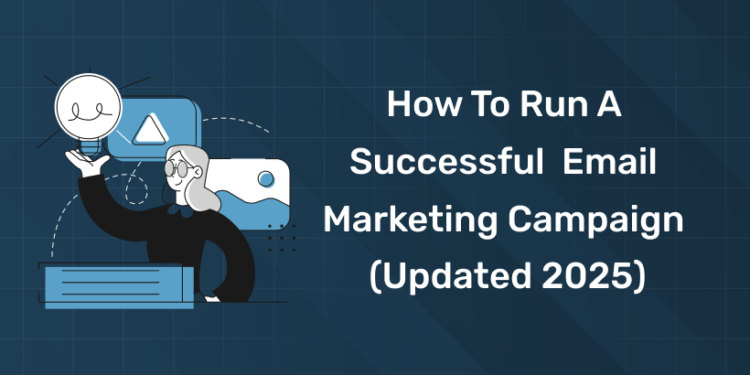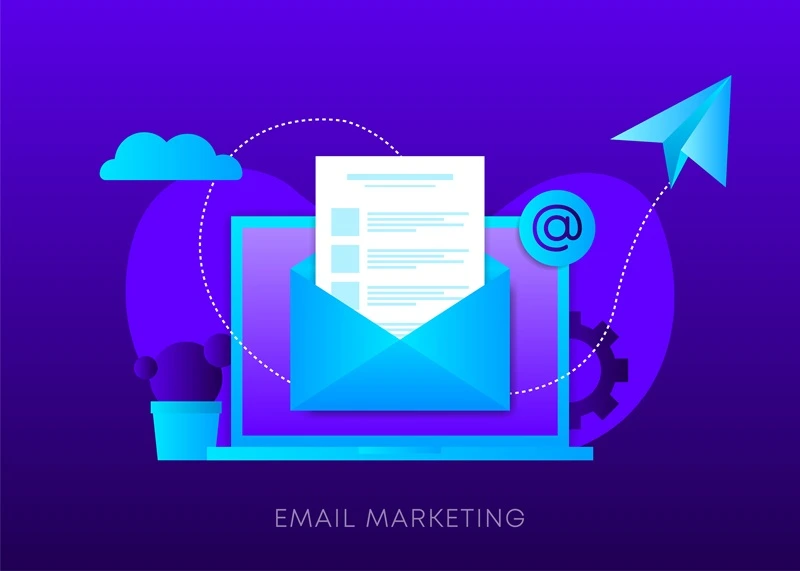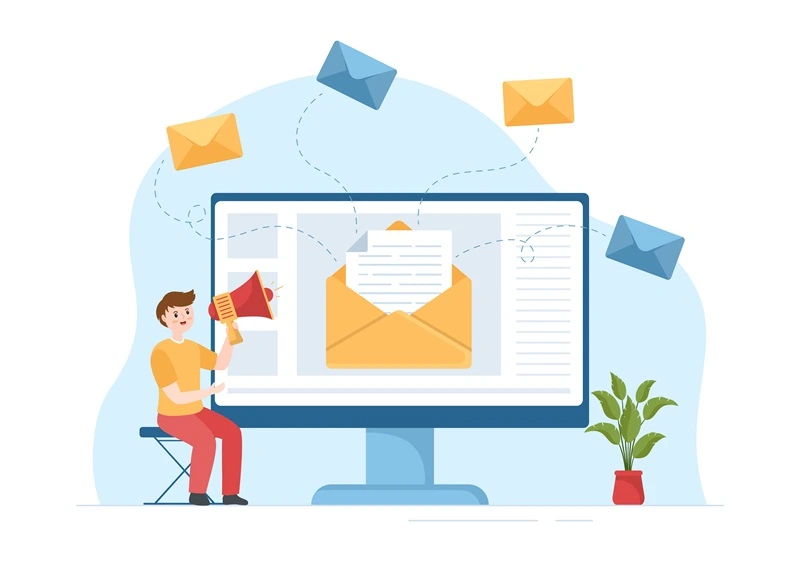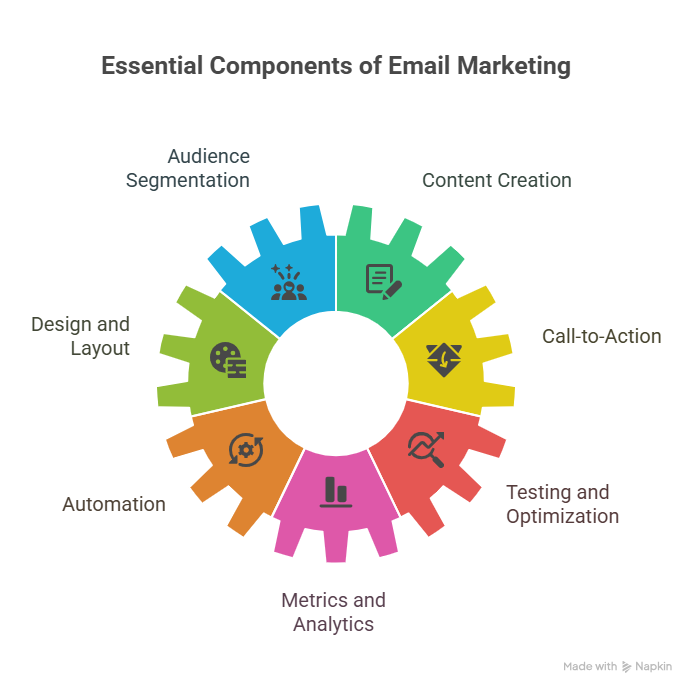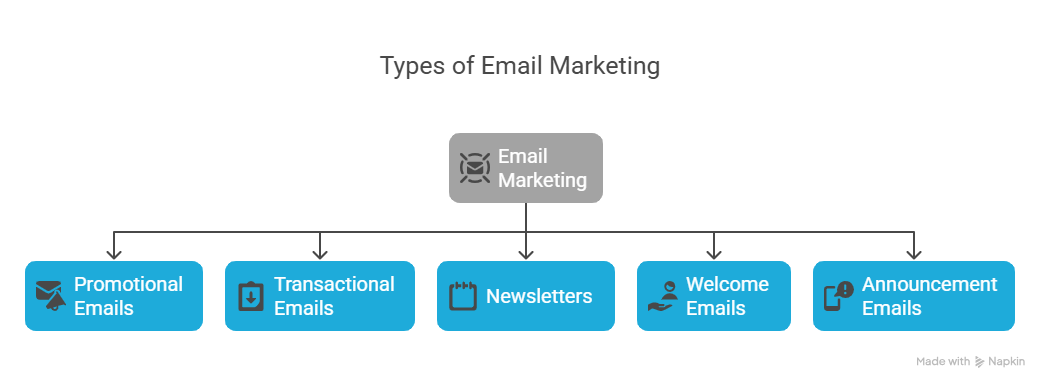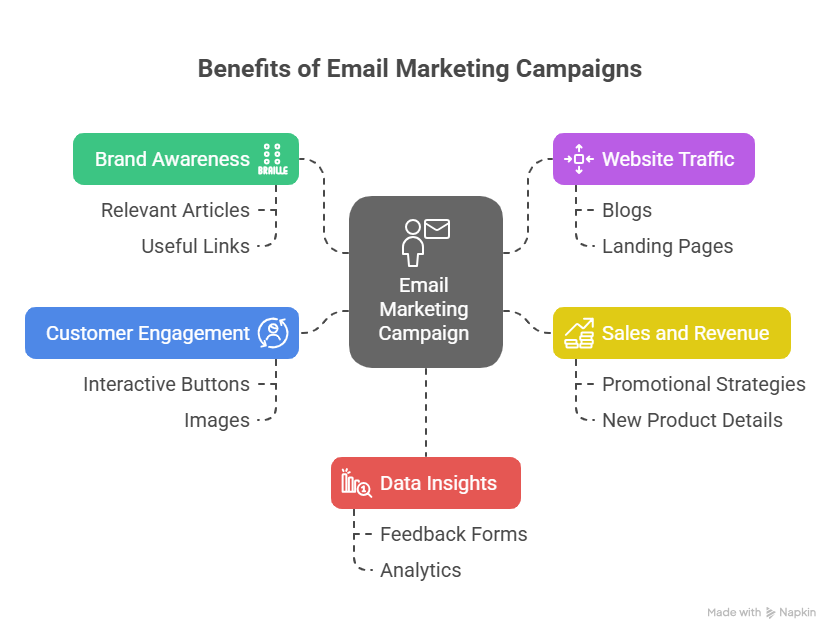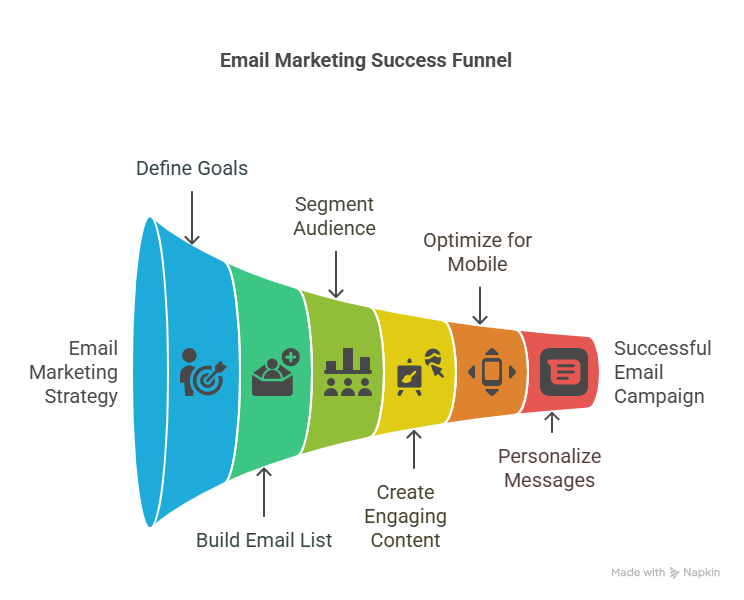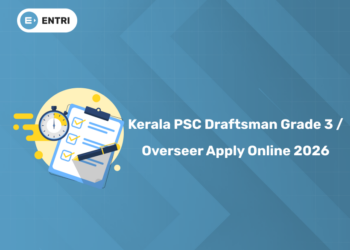Table of Contents
In 2025, email marketing shines in India’s ₹60,000 crore digital ad landscape. With 950 million internet users, it’s a powerful tool for engaging customers and boosting sales. Unlike fleeting social media, email builds loyalty through AI-driven customization and vernacular content. Successful campaigns demand fresh strategies, from data analytics to mobile-first designs. This guide unveils email marketing tactics for 2025, helping brands like Flipkart stay ahead.
Learn Digital Marketing Fundamentals! Get Free Demo Here!
Introduction
One of the best digital marketing platforms for expanding your brand and engaging customers is email marketing. With more than 4 billion email users globally on a regular basis, it offers unmatched reach at an affordable price. Email marketing not only expands your clientele but also fosters a closer bond of loyalty. You may obtain industry-leading email metrics, such as high open, click through, and conversion rates, with the appropriate tactics and gradual optimisation.
Strategic attempts to promote goods, services, or brand awareness through email correspondence with a specific audience are known as email marketing campaigns. Sending announcements, newsletters, or promotional communications to a list of subscribers who have consented to receive emails from the sender is the basis of these campaigns
What are Email Marketing Campaign?
1: What is the primary goal of SEO (Search Engine Optimization)?
Email Marketing Campaign defined as sending emails to a list of clients and prospective clients for promotional purposes. A series of emails sent with a specific marketing goals in mind, such as raising brand awareness, support leads, promoting interaction, introducing new features, making updates known, or validate goods and services, will making up an email marketing campaign.
The email marketing campaigns will encompasses the purposeful development and distribution of promotional emails to a specific audience. Audience segmentation, content production, design and layout, scheduling and personalisation automation and performance tracking, these are the essential elements of email marketing campaigns.
Become an AI-powered Digital Marketing Expert
Master AI-Driven Digital Marketing: Learn Core Skills and Tools to Lead the Industry!
Explore CourseKey Elements of Email Marketing Campaigns
Email marketing campaigns serve as an effective tool for businesses to engage with their audience, nurture leads, drive conversions, and build brand loyalty over time.
- Audience Segmentation: Subscribers are often segmented based on factors such as demographics, interests, purchase history, or engagement level. This allows for more personalized and targeted messaging.
- Content Creation: Campaigns require the creation of compelling and relevant content, including promotional offers, educational resources, company updates, or curated content.
- Design and Layout: The visual presentation of emails is crucial for grabbing attention and conveying the message effectively. Design elements such as images, colors, typography, and layout contribute to the overall appeal and readability of the email.
- Call-to-Action (CTA): Every email should include a clear and compelling call-to-action prompting recipients to take a desired action, such as making a purchase, signing up for a webinar, or downloading a resource.
- Automation: Automation tools enable marketers to schedule emails, set up drip campaigns, and trigger personalized messages based on specific actions or events, such as website visits, email opens, or abandoned carts.
- Testing and Optimization: A/B testing allows marketers to experiment with different email elements (subject lines, content, CTAs) to determine what resonates best with their audience. Continuous monitoring and analysis of campaign performance help in refining strategies for better results.
- Metrics and Analytics: Tracking key metrics such as open rates, click-through rates, conversion rates, and unsubscribe rates provides insights into the effectiveness of the campaign and informs future decisions and optimizations.
Types of Email Marketing
Email Marketing campaigns can use a variety of email formats, some o the various types of email marketing is listed out below.
- Promotional Emails: The main aim of the promotional emails is to advertise some particular products, services, or deals to targeted audience.
- Transactional Emails: Transactional emails includes the certain activities done by the consumers such as their shipping updates, their order confirmations, and also password resets.
- Newsletters: The newsletters are normally scheduled emails. And that will offer for the subscribers news, tips, updates, and other important information about the company or the sector.
- Welcome Emails: The welcome emails are exactly sent to the new consumers as a welcome email. And these welcome email will provide them with an overview of the brand or company.
- Announcement Emails: Announcement emails are designed for informing the announcement like notification to the consumers about the upcoming events, features, or any other required items.
Learn Digital Marketing Fundamentals! Get Free Demo Here!
Benefits of Email Marketing Campaign
Email marketing campaigns are strategic efforts aimed at promoting products, services, or brand awareness through email communication with a targeted audience. These campaigns involve sending commercial messages, newsletters, or announcements to a list of subscribers who have opted in to receive emails from the sender.
Email marketing campaign have several benefits for the firms and brands according to their needs. Among them are listed out below:
1. Increasing the brand awareness
The businesses can use email marketing as promoting themselves, like a brand for their goods, and services by providing their consumers with relevant articles, useful links, news, and updates.
2. Generating the website traffic
Most of the businesses can use email marketing campaign for increasing their website traffic by sending readers to their blogs, landing sites, sales pages, recent arrival pages, and some of the other important pages.
3. Driving the sales and revenue
In some cases these email marketing is very useful tool for businesses development to showcase their goods and services to consumers. And also to experiment with different promotional strategies to increase the growth of the sales in marketing products. One of the relevant examples, promoting the newly arrived products details, by providing free shipping and discounts, using the upselling and cross-selling strategies, etc.
4. Promoting other customer viewpoints
Email marketing is a useful tool for increasing traffic to many marketing channels, including blogs, social media, landing pages, webinars etc. The exact example or this is, inviting the consumers to a virtual gathering when you are hosting.
5. Engaging customers continuously
Creativity is facilitated by email marketing. You can test out different messaging strategies to see what keeps consumers engaged and enthusiastic about your business. For example, you might discover that your audience becomes more engaged when you include interactive buttons or when they see images.
6. Gaining insightful business data
Learning about consumer behaviour and obtaining customer data is made easier with email marketing. Therefore, you can send email feedback forms and client satisfaction surveys, or you can use the analytics feature of email marketing software to accomplish this.
Additionally, you may utilise this information to optimise your communications, products, services, and business. As you are gathering data, remember to ensure email security. Use the DMARC report analyzer in this case to provide your consumers peace of mind that their personal information is secure from hackers.
Become an AI-powered Digital Marketing Expert
Master AI-Driven Digital Marketing: Learn Core Skills and Tools to Lead the Industry!
Explore CourseStrategies for a Successful Email Marketing Campaign
A good email marketing strategy needs to be carefully planned and carried out consequently. Ans the following strategies can help you make sure that, whether your campaign will meets its goal:
Define Your Goals:
In this part, first of all you should establish the objectives of your email marketing strategy. Having specific objectives will direct your tactics to ensure your goal, And will be taking a decision on whether it should be boosting the brand awareness, generating leads, increasing sales, or growing the website traffic.
Build a Quality Email List:
Building a quality email will concentrate on assembling a high-quality email list of subscribers who have agreed to hear from you. And uses a variety of techniques to bring out the consumers who were truly interested in your ideas such as social media, website sign-up forms, and templates.
Segment Your Audience:
Through segment your audience is to dividing up your email list into segments according to the entry level, interests of consumers, according to the past purchases, and statistics of the consumers. This will boosts the relevance and social involvement by enabling you to present highly tailored content and that will appeals to various audience segments.
Create Eye-Catching Subject Lines:
It is very important to make sure your subject line will catches users attention and tempt them to open your email. If you want to discover what resonates most with your audience, you should take assessment with several subject line strategies, such as offering value, expressing curiosity, personalising, or highlighting necessity.
Make Useful Content:
Make sure to post thoughtful and relevant content that will addresses the needs, issues, and interests of your readers. To maintain the readers attention and encourage them to review, provide them with valuable content, special offers and product updates, or provide some interesting materials.
Optimize for Mobile:
Mostly significant numbers of emails were opens take place on mobile devices then it is crucial to enhance your emails for mobile responsiveness. Make sure that your emails should have clickable buttons, clear calls to action, and an eye-catching layout that makes readers easy to read on small displays.
Personalize Your Messages:
Use personalisation techniques to give each recipient of your emails, it is a sense of relevance and customisation. Also use segmented audiences to send personalized messages. And should refer to readers by name, and include product recommendations and strongest content based on their prior experiences with the brand.
Design Engaging Layouts:
Create an attractive email designs that will grab readers attention to your email and lead them through the information with ease of contents . To promote clicks and conversions, should maintain eye catching designs, concise languages, whitespace, and obvious call-to-actions (CTAs) such as text ads.
Evaluate and Rework:
You can assess the different email elements, such as subject lines, content, call to actions (CTAs), and send timings, using A/B testing to optimise performance. Aim for consistent patterns at all times, and modify your approaches based on the results of your testing.
Automate as much as you can:
Using automation technologies to assist in the planning of your email marketing campaigns will allow you to provide subscribers timely, tailored material. To effectively nurture leads and increase conversions, drip marketing, welcome emails, forgotten basket alerts, and other tasks can be automated.
Learn Email Marketing Fundamentals! Get Free Demo Here!
Tips for Running Successful Email Marketing Campaigns
1. Set Clear Goals:
For example, you can set measurable targets for your email campaigns to increase sales, drive traffic to your website, or develop your subscriber list. Well-defined goals will direct your approach and facilitate the assessment of your accomplishments.
2. Know Your Audience
Your message is for no one if it is meant for everyone. These days, consumers want personalised messages and highly relevant offers from the brands they deal with; generic emails are no longer acceptable. But in order to send tailored emails, you need to know more about your recipients than just their demographics.
- What needs, preferences, and interests do they have?
- What time and method of email delivery do they prefer?
- What distinguishing characteristics make them stand out from the masses?
- What is the subscriber’s benefit?
The answers to these queries won’t become clear to you immediately. But eventually, after a few email campaigns, you’ll have enough information and understanding of each cohort of subscribers to begin effectively segmenting them.
3. Build a Quality Email List
No matter how many subscribers you have 10, 100, or 1,000 they most likely have different demands, tastes, and passions. This implies that a batch-and-blast strategy would provide little to no benefits. Many unsuccessful email marketing initiatives have one thing in common: the sender sent the identical message to everyone, regardless of their needs, which is why the campaign didn’t work. For instance, a generic email with an update on new hardware is sent to the individual who requests to get information about offers on computer software.
You must segment your list if you want your campaigns to be really successful. Compared to non-targeted marketing, segmented campaigns get 50% greater click-through and open rates. You can group items on your list according to a number of criteria, such as:
- Characteristics
- Frequency of emails requested
- Interest in the content
- Whereabouts
- History of purchases
- Email access time
4. Personalize Your Emails
Personalisation is driven by segmentation. Put differently, it enables you to send emails that each segmented list responds to. Remember that segmentation is more than just addressing consumers by name.
Make sure you obtain more specific information about every consumer category so you can send them tailored offers, deals, and other things. Additionally, choose words that will help the subscribers understand what you’re saying. Your consumer base will be more receptive to personalised communications since they will be able to see that you are able to anticipate their demands.
5. Check For Grammar and Errors
It should go without saying that you should use proper language and spelling when communicating with your subscribers. Additionally, be sure to change the message to reflect the tone and aesthetic that are associated with your brand. Above all, keep in mind that emails that are friendly, convincing, and interesting to read will probably capture readers’ attention.
6. Keep Your Layout Simple
Keep the number of images in your emails to a minimum. If you do this, you run the risk of having too many subscribers and having your emails end up in spam. Instead, make sure your layout is straightforward to avoid detracting from the primary point of the email. Your main point will be concise, understandable, and effectively expressed using a straightforward structure that makes good use of whitespace.
7. Don’t Overload on Copy
It’s simple to let emails go on for many paragraphs if you have a lot to say, but keep in mind that your readers probably don’t have much time to read them. Try to keep your message as brief as possible. If you have more to say, you can offer a link to a landing page so that your subscribers can read it.
You don’t have to use a tonne of copy to convey what you want to express in emails. Go as creative as you can with your email copy, but remember to limit each paragraph to no more than two or three sentences.
8. Include a Call-to-Action
You want the people who receive your emails to do more than just read them; you want them to act. A clear call-to-action (CTA) is crucial in this situation. What do you want the recipients of your emails to do? A few examples of CTAs are:
- Completing an online form
- To read more, click the provided link.
- Going to your product page or website to make a purchase
- Signing up for a webinar
- Getting a Whitepaper Down
9. Create a Compelling Subject Lines
Strong email subject lines are essential to drawing in consumers and preventing your emails from getting deleted before they are even viewed. Select attention-grabbing subject lines for your emails, but make sure the content lives up to the hype. Being deceptive can aggravate your subscribers and might even drive them to unsubscribe from your emails, so avoid doing that.
10. Use Email Automation in Email Marketing
If your company and marketing initiatives are just getting started, you most likely need to juggle a lot of duties to keep your small business running smoothly. In addition to denying yourself time for other responsibilities, manually managing your email campaigns. This leaves you vulnerable to mistakes made by people and lost chances. But if you look into email marketing software, you can automate your email marketing, giving you more hours in the day to manage other crucial business operations and doing more in less time.
Email workflows eliminate the need for you to manually send emails to consumers at each stage of the buying process and set a timer. A solid email automation software programme, like Benchmark Email, starts sending out messages in response to actions taken by subscribers.
Conclusion
In 2025, running a successful email marketing campaign requires a strategic approach that embraces innovation and adaptability. By understanding your audience, personalizing content, optimizing for mobile devices, and focusing on engagement, you can elevate your email marketing efforts to new heights. Implementing automation and measuring results will further enhance your campaigns. Stay informed about emerging trends and technologies in the ever-evolving landscape of email marketing to maintain a competitive edge and drive meaningful results for your business.
The Entri Elevate Digital Marketing Course is a comprehensive program designed to equip students with the skills and knowledge necessary for success in the dynamic field of digital marketing. The course covers a wide range of topics, including social media marketing, search engine optimization (SEO), content marketing, and email marketing. Students will learn how to create and execute effective digital marketing campaigns, measure their results, and adapt their strategies based on data and insights. Additionally, the course includes a capstone project that allows students to apply their learning to a real-world scenario.
Frequently Asked Questions
What are the three aspects for a successful email marketing strategy?
Take a comprehensive approach to your email programme with the aid of the three pillars of a successful email programme: PRE, POST, and PERFORM. Over the next few weeks, we’ll go deeply into each and every one of them.
Is email marketing still relevant in 2025?
Email marketing is still proving to be a valuable technique in digital marketing as we move closer to 2025. This has to do with effectiveness, not merely custom.
How to run a successful email marketing campaign step by step?
- Describe who your audience is.
- Establish objectives.
- Select a platform for email marketing.
- Choose the type of campaign.
- Create a list of emails.
- Divide up your list.
- Make an email.
- Check your email.
What is the most effective email marketing campaign strategy?
You receive more leads, transactions, revenue, and greater open rates when you segment your lists. Additionally, segmented email campaigns boost business income by 760%, per Campaign Monitor study. Segmentation and email marketing go hand in hand with GDPR, which is another advantage.


